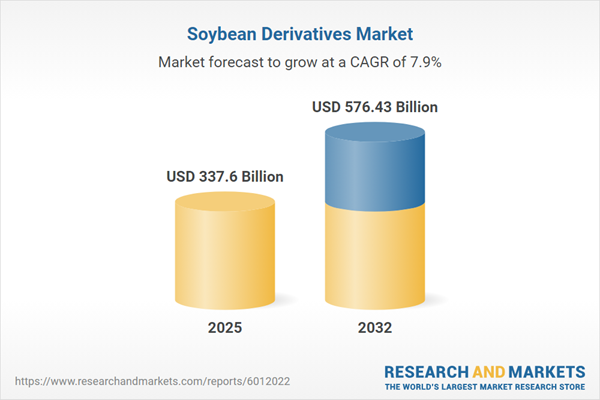Speak directly to the analyst to clarify any post sales queries you may have.
Senior decision-makers navigating complex global value chains turn to the soybean derivatives market for crucial insights, balancing regulatory trends and sustainable sourcing strategies to maintain a competitive edge and resilient supply structures.
Market Snapshot: Global Soybean Derivatives Market Overview
The global soybean derivatives market attained a value of USD 313.21 billion in 2024, with projections pointing to USD 337.60 billion by 2025 and USD 576.43 billion by 2032, reflecting a CAGR of 7.92%. This robust expansion is fueled by changing consumption patterns, increasing demand in nutritional and industrial spheres, and heightened innovation throughout the supply chain. Businesses investing in process enhancements and staying abreast of regulatory requirements are setting the standard for sourcing continuity and operational agility. Senior executives place strong emphasis on developing stable procurement channels and integrating technological advancements to ensure strategic growth within the soybean derivatives sector.
Soybean Derivatives Market Scope & Segmentation
- Product Types: Soybean lecithin, crude and refined soy oils, and protein ingredients—concentrates, isolates, and textured proteins—serve sectors such as food manufacturing, animal feed, and a range of industrial uses.
- Applications: Products address the requirements of animal feed—including livestock, aquaculture, poultry, and pet food—as well as plant-based dairy alternatives, processed snacks, and industrial applications like biofuels, pharmaceuticals, plastics, and cosmetics.
- Forms: Soybean derivatives are supplied as liquids (oils and slurries) and solids (powders and granules), providing flexibility and efficiency for procurement and processing workflows.
- Distribution Channels: Industry supply operates through specialty retailers, major grocery networks, B2B online platforms, and global e-commerce providers, supporting various procurement strategies from local to international scale.
- Regions & Markets: The market spans the Americas, Europe, the Middle East, Africa, and Asia-Pacific, with supply chain investments in the Americas and Asia-Pacific targeting operational resilience. Regional regulatory environments shape access and compliance strategies.
- Technology Trends: Innovations such as enzymatic extraction, cold pressing, and fermentation drive process efficiency, while emerging digital tools and blockchain adoption improve transparency and compliance monitoring.
Key Takeaways for Senior Decision-Makers
- Portfolio realignment towards clean-label and multifunctional ingredients enables organizations to address evolving consumer expectations and regulatory demands effectively.
- Advanced processing initiatives promote dependable supply chains and facilitate progress toward sustainability milestones relevant to modern corporate agendas.
- Strategic partnerships with technology firms help accelerate traceability, strengthen risk controls, and improve end-to-end supply chain management.
- Establishing sources for non-GMO and certified organic soybeans provides entry into premium markets and aligns with stricter sustainability benchmarks.
- Diversifying operations across food, feed, and industrial applications ensures access to new growth avenues and supports ongoing business adaptability amid changing environments.
- Regional investment strategies support quick adaptation to policy and economic changes, maintaining continuity across varying market conditions.
Tariff Impact: United States Tariffs and Market Dynamics
Newly introduced United States tariffs for 2025 have prompted organizations to reassess procurement and supplier relationships. Executives are expanding supplier networks, prioritizing domestic processing options, and optimizing supply frameworks to reduce price volatility and remain compliant with evolving regulations.
Methodology & Data Sources
This analysis is built on extensive secondary research, targeted industry literature, and direct feedback from manufacturers, suppliers, and buyers. An independent expert panel reviewed the findings, which are supplemented by case studies offering regional context for core market segments.
Why This Report Matters: Soybean Derivatives Market
- Helps leadership teams identify potential risks, discover expansion opportunities through organic growth or acquisitions, and fine-tune strategies in response to market or regulatory developments.
- Guides improved product selection and procurement, ensuring approaches are tailored for regional and sector-specific requirements.
- Provides actionable recommendations for leveraging digital tools and technology to improve transparency and achieve measurable sustainability within the soybean derivatives supply chain.
Conclusion
A strategic, data-driven approach empowers organizations to build resilient sourcing models and generate long-lasting value as the soybean derivatives market advances in complexity and global reach.
Additional Product Information:
- Purchase of this report includes 1 year online access with quarterly updates.
- This report can be updated on request. Please contact our Customer Experience team using the Ask a Question widget on our website.
Table of Contents
3. Executive Summary
4. Market Overview
7. Cumulative Impact of Artificial Intelligence 2025
Companies Mentioned
The companies profiled in this Soybean Derivatives market report include:- Archer Daniels Midland Company
- Bunge Limited
- Cargill, Incorporated
- Louis Dreyfus Company B.V.
- Wilmar International Limited
- CHS Inc.
- COFCO International Ltd.
- Olam International Limited
- Viterra Inc.
- Richardson International Limited
Table Information
| Report Attribute | Details |
|---|---|
| No. of Pages | 183 |
| Published | November 2025 |
| Forecast Period | 2025 - 2032 |
| Estimated Market Value ( USD | $ 337.6 Billion |
| Forecasted Market Value ( USD | $ 576.43 Billion |
| Compound Annual Growth Rate | 7.9% |
| Regions Covered | Global |
| No. of Companies Mentioned | 11 |









